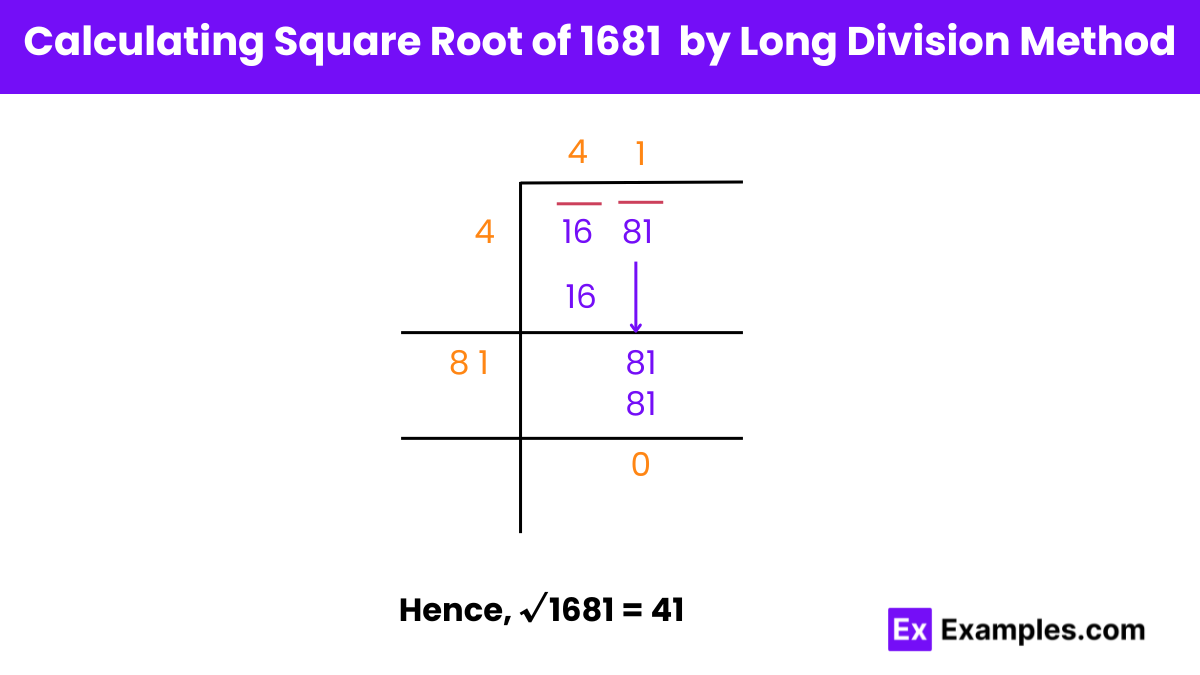Square & Square Root of 1681
Within algebraic studies, squares and square roots play pivotal roles. Squaring a number, exemplified by multiplying 1681 by itself to yield 2825761, is fundamental. It’s a cornerstone in exploring properties of rational (expressible as a fraction) and irrational numbers. Understanding these concepts enriches comprehension of mathematical relationships and patterns. Whether investigating the elegant simplicity of rational numbers or the enigmatic nature of irrationals, squares and square roots serve as foundational tools. They reveal the intricacies of numerical relationships, demonstrating the interconnectedness of mathematical concepts. Thus, within the realm of mathematics, the significance of squares and square roots extends far beyond mere computation, shaping our understanding of fundamental principles and paving the way for deeper exploration.
Square of 1681
1681²(1681 × 1681) = 2825761
The square number 1681 is obtained by multiplying 41 by itself. It holds significance as the 41st square number. Understanding its properties illuminates concepts of perfect squares and their role in mathematics, showcasing the interplay between algebraic operations and numerical patterns.
Square Root of1681
The square root of 1681, a perfect square, is 41. In mathematics, the square root signifies finding the number that, when multiplied by itself, equals the given value. Understanding square roots is crucial, as they unveil the inverse operation to squaring, pivotal in solving equations and analyzing geometric shapes.
Square Root of 1681 : 41
Exponential Form : 1681^½ or 1681^0.5
Radical Form : √1681
Is the Square Root of 1681 Rational or Irrational?
The square root of 1681 is rational.
The square root of 1681 is a rational number. This means it be expressed as a fraction of two integers, and its decimal representation continues infinitely with repeating a pattern.
Rational Number:
A rational number is a fraction of two integers, expressed as a/b, where a and b are integers and b is not zero. Examples include 3/4, -5/2, 0, 1, -2, etc.
Example:
For instance, 3/4 is rational because it’s a fraction with both numerator and denominator as integers, and the denominator isn’t zero.
Irrational Number:
An irrational number cannot be expressed as a ratio of two integers. Its decimal representation is non-terminating and non-repeating. Examples include √2, π, and φ.
Example:
For example, the decimal expansion of √2 is approximately 1.41421356…, showing a non-repeating and infinite pattern, hence it’s irrational.
Methods to Find the Value of Root 1681
There are several methods to find the square root of 1681:
Prime Factorization: Decompose 1681 into its prime factors (41 * 41), and since the number is a perfect square, the square root is the product of the prime factors, yielding 41.
Estimation Method: Since 1681 is close to 1600 (which is 40 squared), an estimation can be made that the square root is close to 40.
Calculator: Most calculators have a square root function, where you can simply input 1681 and get the square root directly.
Long Division Method: This method involves a step-by-step process of long division similar to manual division, which can be used to approximate the square root.
Newton’s Method: An iterative algorithm can be applied to approximate the square root of 1681 by repeatedly refining an initial guess until it converges to the actual value.
Square Root of 1681 by Long Division Method

Sure, here are the steps rewritten with subheadings:
Square Root of 1681 by Long Division Method
Step 1: Grouping the Number
Write 1681 as shown in the figure. Group the number in pairs from the right: 81 is the first pair from the right, and the next pair is 16.
Step 2: Finding the Largest Number
Find the largest number that, when multiplied by itself, will give 16 or a smaller number closest to 16. Here it is 4 (4 × 4 = 16, remainder = 0).
Step 3: Bringing Down the Next Pair
Bring down the next pair of numbers, which is 81. The new divisor is 81, and the dividend is also 81.
Step 4: Finding the Next Quotient
Find the largest number that, when placed at the ones place with 8 at the tens place, multiplied by that same number, gives 81.
Step 5: Completing the Division
Write 1 as the next quotient place. Now, the new divisor is 81 as 81 × 1 = 81. Complete the division and get the remainder as 0. Thus, the process of division completes here.
1681 is Perfect Square root or Not?
Yes, 180 is a perfect square.
Yes, 1681 is a perfect square. It is the square of 41, as 41 * 41 equals 1681. In mathematics, a perfect square is a number that is the square of an integer, meaning it can be expressed as the product of an integer multiplied by itself.
FAQS
What are some properties of the square root of 1681?
The square root of 1681 is a positive integer.
It is the smallest square root of any perfect square that is greater than 1000.
Can I find the square root of 1681 without a calculator?
Yes, you can find the square root of 1681 manually using methods such as long division, prime factorization, or estimation.
Why is the square root of 1681 important?
Understanding the square root of 1681 helps in various mathematical calculations and applications, such as geometry, engineering, and physics.
Are there any real-life examples involving the square root of 1681?
Yes, one example could be calculating the side length of a square with an area of 1681 square units.



